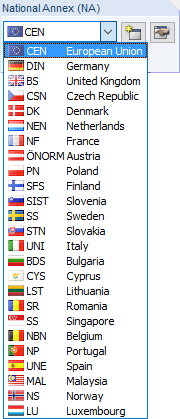Eurocode 3 [1] regulates the draft, design, and construction of steel structures in the member states of the European Union. With the add-on modules RF-STEEL EC3 (for RFEM) and STEEL EC3 (for RSTAB), Dlubal Software provides powerful tools for designing steel structures. Country-specific regulations are taken into account by different National Annexes (NA). In addition to the parameters included in the program, you can define your own limit values or create new National Annexes.
In the following, the add-on modules of both main programs are described in one manual and are referred to as RF-/STEEL EC3.
RF-/STEEL EC3 performs all typical ultimate limit state designs as well as stability and deformation analyses. In the ultimate limit state design, the add-on module considers the effect of various loadings. It is possible to choose among the interaction formulas given in the standard. An essential part of the verification according to Eurocode 3 is the classification of the cross-sections to be designed into classes 1 to 4. This way, the limitation of the capacity to withstand stresses as well as the rotational capacity due to local buckling of cross-section parts is checked. RF-/STEEL EC3 determines the c/t-ratios of the cross-section parts subjected to compression and carries out the classification automatically.
In the stability analyses, you can specify separately for each member or set of members whether flexural buckling in the y- and/or z-direction is possible. You can also define additional lateral restraints in order to represent the model close to reality. In addition, the stabilizing effect of purlins and sheets can be taken into account by rotational restraints and shear panels. Based on the boundary conditions, RF-/STEEL EC3 determines the slenderness ratios and elastic critical buckling loads. The elastic critical moment for lateral-torsional buckling required for the lateral-torsional buckling analysis can be determined automatically or specified manually. The program takes into account the load application point of transverse loads, which has a decisive effect on the torsional resistance.
RF-/STEEL EC3 performs the fire resistance design according to EN 1993-1-2 [2]. The design is carried out on the bearing capacity level according to the simplified calculation method. Claddings with different physical properties can be selected as fire protection measures.
The serviceability limit state represents an important design for structures with slender cross-sections. Load cases, load combinations, and result combinations can be assigned to different design situations. The limit deformations are preset by the National Annex and can be adjusted, if necessary. In addition, it is possible to specify reference lengths and precambers that will be considered accordingly in the design.
RF-/STEEL EC3 also allows you to design structural components made of stainless steel according to EN 1993-1-4 [4].
If you have a license for the "RF-/STEEL Cold-Formed Sections" module extension, the design of cold-formed components according to EN 1993-1-3 [3] is also possible.
The add-on module provides an automatic cross-section optimization with the possibility to export modified cross-sections to RFEM or RSTAB. Separate design cases allow for the flexibility to analyze individual structural components in complex structures.
Like other add-on modules, RF-/STEEL EC3 is completely integrated in the RFEM or RSTAB program. Thus, the design-relevant input data is preset when you have started the add-on module. Subsequent to the design, you can use the graphical user interface of the main program to evaluate the results. As they are also included in the global printout report, the entire verification can be presented in a consistent and appealing form.
This manual also describes the following two module extensions for RF-/STEEL EC3:
- RF-/STEEL Warping Torsion
- RF-/STEEL Plasticity
- RF-STEEL Cold-Formed Sections
We wish you pleasant and successful working with RF-/STEEL EC3.
Your Dlubal Software team
Literature
[1] European Committee for Standardization (CEN). (2010). Eurocode 3: Design of Steel Structures – Part 1‑1: General Rules and Rules for Buildings, EN 1993-1-1:2005. Berlin: Beuth Verlag GmbH.
[2] European Committee for Standardization (CEN). (2010). Eurocode 3: Design of Steel Structures – Part 1-2: General Rules – Structural Fire Design, EN 1993-1-2. Berlin: Beuth Verlag GmbH.
[3] European Committee for Standardization (CEN). (2010). Eurocode 3: Design of Steel Structures – Part 1‑3: General Rules – Supplementary Rules for Cold-Formed Members and Sheeting, EN 1993‑1‑3:2010‑12. Berlin: Beuth Verlag GmbH.
[4] European Committee for Standardization (CEN). (2007). Eurocode 3: Design of Steel Structures − Part 1-4: Supplementary rules for stainless steels. Berlin: Beuth Verlag GmbH.
